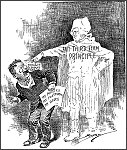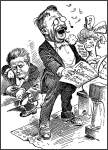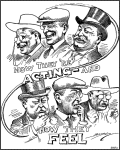what was happening historically during this time that led to this cartoon being made?
Political Cartoons Illustrating Progressivism and the Election of 1912
Groundwork
The Progressive Era, as the period in history at the turn of the 20th century has come to exist known, was a time of tremendous social, economic, and political changes, and the presidential election of 1912 typified the reform spirit of the period. Beginning in the late 1800s with the challenge to the "spoils system" of machine politics, progressivism gathered momentum between 1900 and 1916, as the want for reform permeated the minds of the American people. Reformers themselves were a diverse group, frequently with different views, but always the same general purpose-- to reform America. Amid them were politicians, labor leaders, religious leaders, and teachers, men and women who believed the federal government needed to address the ills of a modern industrialized society. Among their choices for president in 1912 were three major candidates, each of whom laid merits to successful reform measures.
The more than famous reform leaders of the mean solar day reflected the diversity inside the various reform groups. Robert Yard. La Follette, the senator and quondam governor of Wisconsin, and Theodore Roosevelt, the former governor of New York and president of the The states from 1901 to 1908, were members of the Republican Party. Woodrow Wilson, former governor of New Bailiwick of jersey and president from 1912 to 1920, was a member of the Democratic Party. Each man had a history of challenging the condition quo and enacting modify while in part. Yet, they opposed each other during a campaign year that captivated the American people and challenged the two-party system. In their opposition they brought to the forefront of American politics those issues that needed rapt attention, and they succeeded in addressing many of them, regardless of party affiliations.
Equally president from 1901 to 1908, Theodore Roosevelt believed it was his duty to ascertain the major problems of the 24-hour interval and to offering solutions. He believed the dominant issue before the federal government was its relationship with big business organization. He pressed for government regulation of corporations and an end to unfair pricing practices. He considered labor unions and farmers' cooperatives advantageous as a means of keeping the actions of big business in check. Roosevelt carried out 44 antitrust prosecutions, all the while assuring tense businessmen that he was just against enterprises which misused their size and economy of scale to discriminate confronting competitors and deceive consumers. Other important issues for which he attempted to garner support included a graduated income tax and an inheritance tax; initiative, plebiscite and remember measures; straight primaries; and conservation.
Having stated in 1904 that he would serve no more than two terms, Roosevelt endorsed Senator William Howard Taft as the Republican nominee in 1908. However, Taft proved more conservative than Roosevelt had anticipated, and somewhen he regretted his endorsement. In Roosevelt's optics, Taft had too ofttimes sided with the corporate giants and political bosses he had so relentlessly battled.
Taft was also criticized by Senator La Follette who had vied with him for the Republican nomination in 1908. La Follette was arguably the most fervent reformer in the country with an impressive record of achievements in Wisconsin, among them pure food acts, child labor and compulsory education laws, and workmen's compensation insurance. His own larger reform platform, which eventually would be called the "Wisconsin idea," included the dictum of straight election of U. S. senators. As the highest profile Republican other than Theodore Roosevelt, La Follette believed himself to be the natural selection for the party'south nomination in 1912, and progressive Republicans supported him, including Roosevelt.
In January 1911 at La Follette'due south dwelling house in Wisconsin, a de facto Republican nominating committee reorganized as the National Progressive Republican League outlined their new platform, which called for 1) the directly election of U.S. senators, 2) direct primaries, 3) the direct election of convention delegates, and four) a constitutional subpoena for initiative, referendum, and recall at the federal level. If Roosevelt would not seek a third term, then La Follette was their obvious choice for leader. All the same, by late in that year, the members abased La Follette as their candidate when the immensely popular Roosevelt finally threw his hat dorsum in the band."Fighting Bob's" success had shown that the party was viable, but Roosevelt'south notoriety and national entreatment made his chances of winning much greater.
The first two featured documents, both political cartoons, satirize Roosevelt'southward reversal of his anti-third term promise and his assumption of leadership of the Progressive Party. Both La Follette and Roosevelt lost the Republican nomination to the incumbent, Taft, who still controlled the national convention delegates. Roosevelt, nevertheless, had swept ix of the 12 states with primaries, including Taft'south dwelling house state of Ohio. This primary battle is characterized in the third featured document, a political cartoon picturing Ohio equally the "Mother of Presidents." Victories in these primaries made Roosevelt and his progressives confident that they represented the volition of the people. They officially appear their Progressive Party and challenged Taft and the Democratic candidate, Woodrow Wilson. The fourth featured document, another political cartoon, displays the three candidates soon before ballot 24-hour interval in 1912.
As opponents, Roosevelt and Wilson had almost every bit much in common every bit they did in conflict. They both rejected the Republican's platform of status quo and opposed radical groups such as Eugene Deb's Socialist Party of America. They both ran on records of political and economical reform, and they both supported stronger democratization of the political procedure. Withal Wilson, a Democrat, remained concerned for states' rights, disagreeing with Roosevelt'south mandate for federal control of manufacture. Rather, he advocated more precise business laws and prosecution for unfair business concern practices. He likewise called for a reduced tariff, something he associated with the protection of monopolies and special interests and the ascent cost of living. Overall, Wilson was for limiting government power and was in stark opposition to such Roosevelt social welfare programs as workmen's compensation and the minimum wage.
The election of 1912 was the nearly memorable election of the Progressive Era and one of the nigh unique of the 20th century. With reform-minded candidates every bit the top contenders, information technology was only a matter of time earlier the varied goals of the groups inside the Progressive Party, from labor bug to conservation measures, would exist addressed through legislation. In fact, several of import ramble bug were near resolution during the campaign year. The 16th and 17th Amendments to the Constitution were passed during Taft'southward administration and ratified early in Wilson's starting time term. Thus, Congress gained the power to collect income taxes, and U. S. Senators would be elected by the people. In addition, women gained voting privileges when the 19th Subpoena was ratified in 1920.
Resources
Aaseng, Due north. America'due south Third-political party Presidential Candidates. Minneapolis, MN: The Oliver Press, Inc., 1995.
Blum, J. M. The Progressive Presidents. New York, NY: W. W. Norton & Company, 1980.
Peterson, A. The Election of 1912. Lakeside, CA: Interaction Publishers, 1992.
Agreement and Creating Political Cartoons. Madison, WI: Knowledge Unlimited, 1998.
The Documents
Anti-3rd Term Principle

Click to Enlarge
National Archives and Records Administration
Records of the United States Senate, Office of Senate Curator
Record Group 46
National Athenaeum Identifier: 306175
Progressive Fallacies

Click to Enlarge
National Athenaeum and Records Administration
Records of the United States Senate, Part of Senate Curator
Record Group 46
National Archives Identifier: 306096
Ohio, The Female parent of Presidents

Click to Enlarge
National Athenaeum and Records Administration
Records of the United States Senate, Office of Senate Curator
Tape Grouping 46
National Archives Identifier: 306104
How They're Acting and How They Feel

Click to Overstate
National Archives and Records Assistants
Records of the United States Senate, Part of Senate Curator
Record Group 46
National Archives Identifier: 306083
Source: https://www.archives.gov/education/lessons/election-cartoons
0 Response to "what was happening historically during this time that led to this cartoon being made?"
Post a Comment